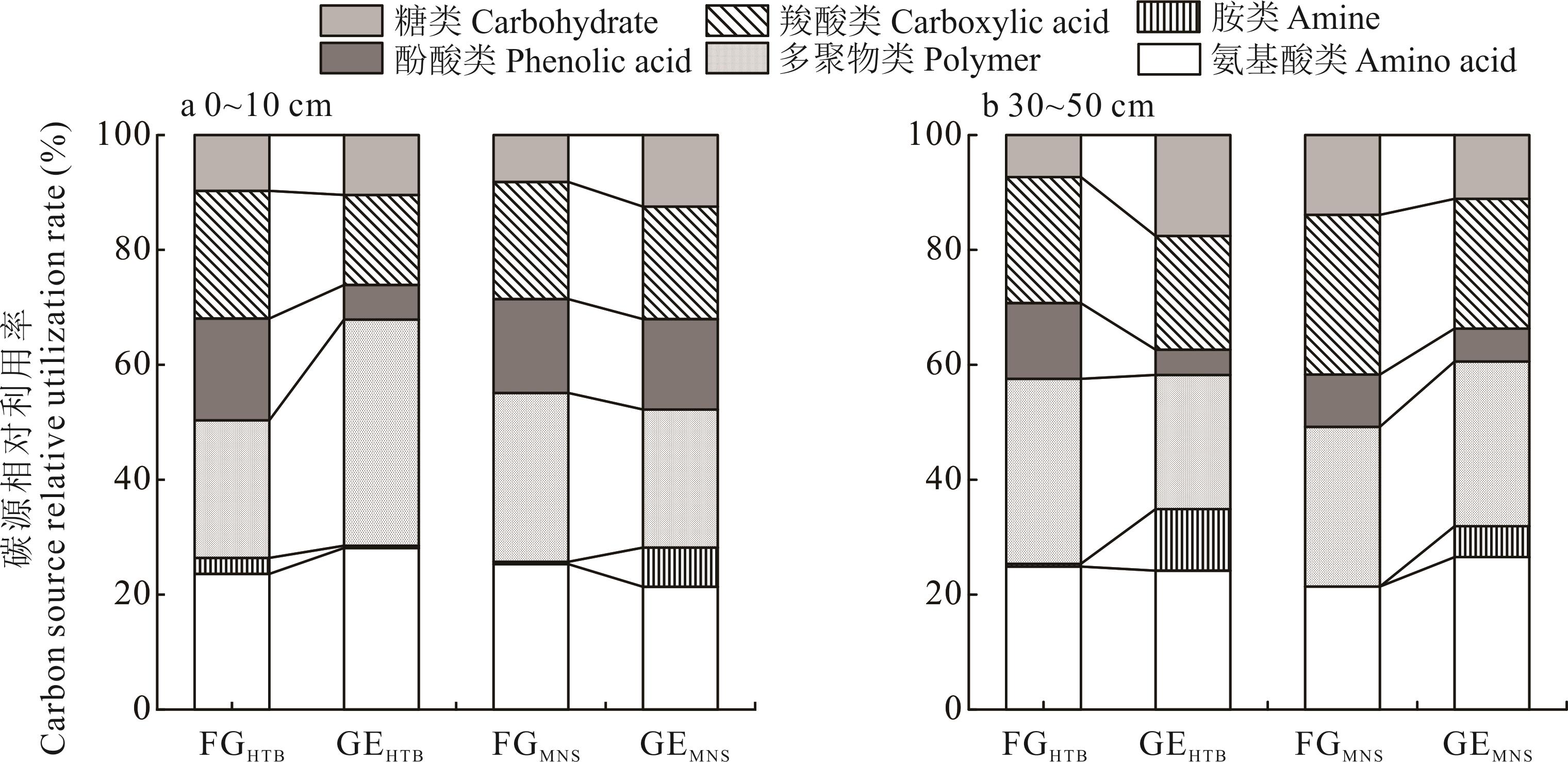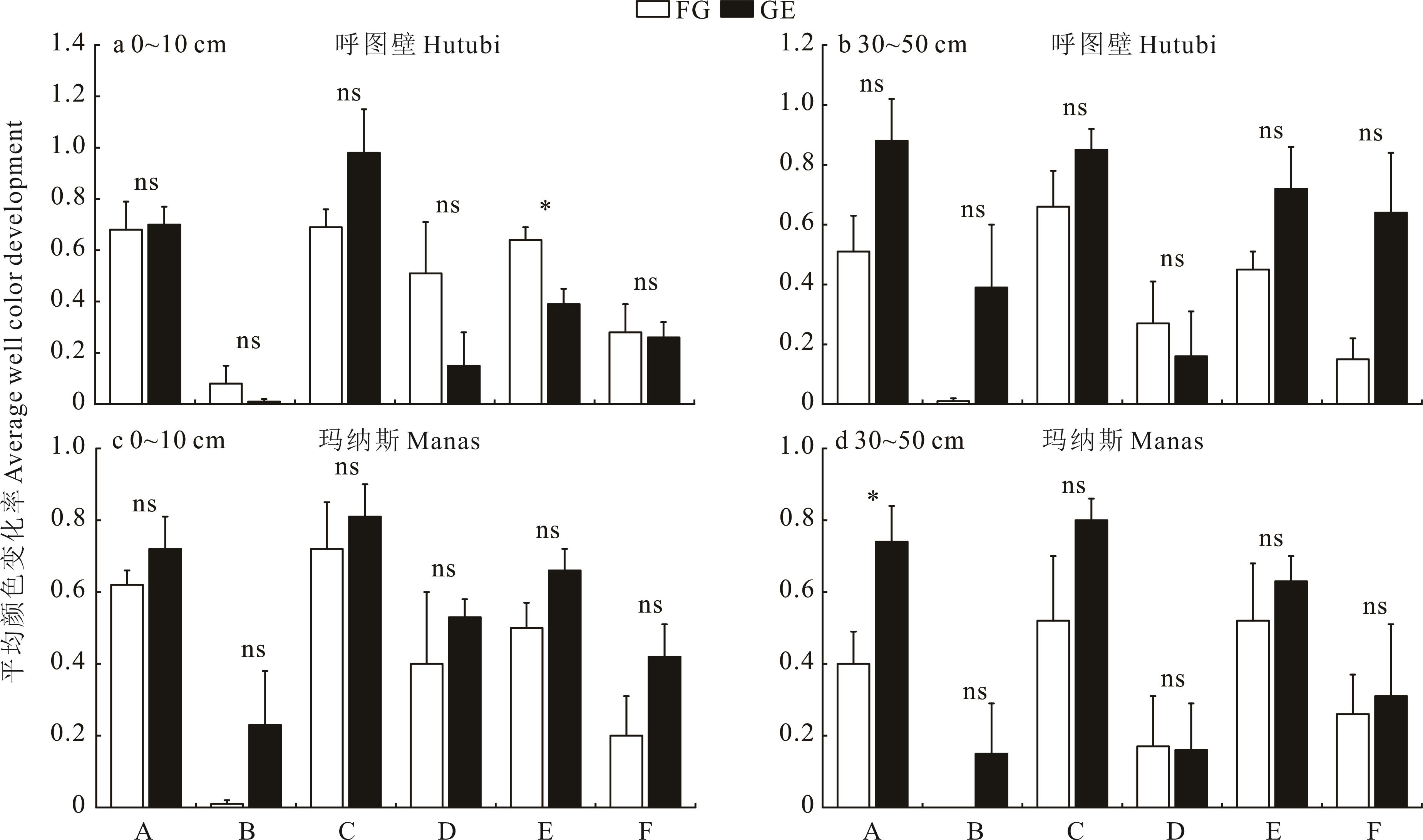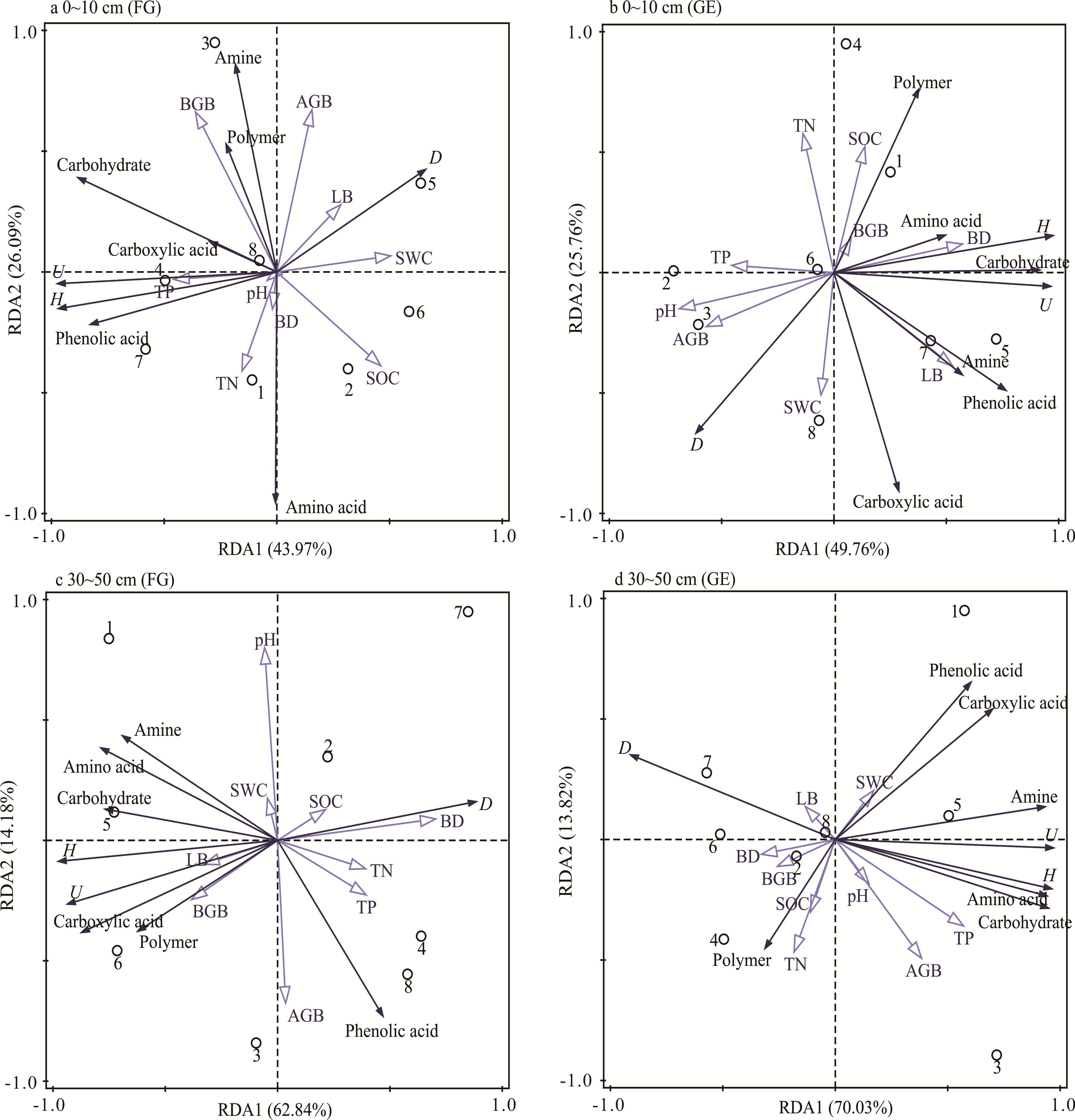

ISSN 1004-5759 CN 62-1105/S


草业学报 ›› 2025, Vol. 34 ›› Issue (1): 29-40.DOI: 10.11686/cyxb2024071
阿斯太肯·居力海提null1( ), 孙宗玖1,2,3(
), 孙宗玖1,2,3( ), 于冰洁1, 迪达尔·比苏力旦null1, 李美莎1, 敬一胜1
), 于冰洁1, 迪达尔·比苏力旦null1, 李美莎1, 敬一胜1
收稿日期:2024-03-05
修回日期:2024-04-17
出版日期:2025-01-20
发布日期:2024-11-04
通讯作者:
孙宗玖
作者简介:E-mail: nmszj@21cn.com基金资助:
ASITAIKEN·Julihaiti1( ), Zong-jiu SUN1,2,3(
), Zong-jiu SUN1,2,3( ), Bing-jie YU1, DIDAER·Bisulidan1, Mei-sha LI1, Yi-sheng JING1
), Bing-jie YU1, DIDAER·Bisulidan1, Mei-sha LI1, Yi-sheng JING1
Received:2024-03-05
Revised:2024-04-17
Online:2025-01-20
Published:2024-11-04
Contact:
Zong-jiu SUN
摘要:
为探究蒿类荒漠草地土壤微生物碳源利用特征对封育的响应规律,以新疆昌吉回族自治州呼图壁县和玛纳斯县蒿类荒漠草地为对象,采取野外实地调查及室内分析相结合的方法,对封育内外土壤微生物碳源利用特征进行测定,并结合植被特征、土壤理化性质对其驱动因素进行分析。结果表明:1)封育后蒿类荒漠草地地上生物量及凋落物生物量分别显著增加142.53%~250.05%和135.68%~259.84%(P<0.05),0~10 cm、30~50 cm土层土壤有机碳、全氮和全磷含量分别增加4.88%~35.33%、10.48%~46.58%和4.48%~21.88%,其中全氮和全磷含量部分变化显著(P<0.05);2)封育后蒿类荒漠草地土壤微生物群落对6类碳源利用程度均明显增加,且两个土层表现一致(P>0.05);3)封育后微生物群落功能多样性除呼图壁样地0~10 cm土层外,其余土层McIntosh指数和Shannon-Wiener指数分别增加14.72%~47.01%和36.29%~74.76%,而Simpson指数降低1.09%~7.53%(P>0.05)。封育提高了蒿类荒漠草地微生物多样性;4)通过冗余分析,发现封育下蒿类荒漠草地0~10 cm土层微生物碳源主要驱动因子为土壤有机碳和凋落物,而30~50 cm土层则为土壤全磷和地上生物量。综上所述,封育加强了蒿类荒漠草地土壤微生物的代谢活性,推动了蒿类荒漠草地生态系统的养分循环和转化(有机碳、全氮和全磷),提高了蒿类荒漠草地微生物多样性,促进了蒿类荒漠退化草地的恢复。
阿斯太肯·居力海提null, 孙宗玖, 于冰洁, 迪达尔·比苏力旦null, 李美莎, 敬一胜. 封育对蒿类荒漠草地土壤微生物碳源利用特征的影响[J]. 草业学报, 2025, 34(1): 29-40.
ASITAIKEN·Julihaiti, Zong-jiu SUN, Bing-jie YU, DIDAER·Bisulidan, Mei-sha LI, Yi-sheng JING. Effects of enclosure on soil microbial carbon source utilization characteristics of sagebrush desert grassland[J]. Acta Prataculturae Sinica, 2025, 34(1): 29-40.
项目 Item | 指标 Index | 土层 Soil layer (cm) | 呼图壁Hutubi | 玛纳斯Manas | ||
|---|---|---|---|---|---|---|
| 放牧Freely grazing | 封育Grazing exclusion | 放牧Freely grazing | 封育Grazing exclusion | |||
生物量 Biomass (g·m-2) | 地上Aboveground | - | 82.29±10.08b | 199.58±14.62a | 64.30±10.66b | 225.08±19.20a |
| 凋落物Litter | - | 9.91±3.06b | 35.66±3.62a | 9.39±1.54b | 22.13±1.90a | |
| 地下Belowground | 0~10 | 164.45±72.15a | 206.50±30.95a | 253.42±149.84a | 107.00±54.22a | |
| 30~50 | 22.40±5.54b | 98.25±29.03a | 54.17±6.50a | 23.83±10.13a | ||
土壤理化性质 Soil physicochemical properties | 酸碱度pH | 0~10 | 7.96±0.04a | 7.91±0.10a | 8.39±0.01a | 8.32±0.09a |
| 30~50 | 8.28±0.16a | 8.27±0.16a | 8.39±0.10a | 8.59±0.16a | ||
| 容重Bulk density (g·cm-3) | 0~10 | 1.31±0.02a | 1.31±0.03a | 1.16±0.03a | 1.24±0.04a | |
| 30~50 | 1.40±0.09a | 1.42±0.04a | 1.25±0.09a | 1.29±0.03a | ||
| 含水量Water content (%) | 0~10 | 4.62±1.05a | 3.08±1.08a | 1.97±0.50a | 2.95±0.60a | |
| 30~50 | 8.23±2.09a | 5.66±0.93a | 6.31±1.18a | 5.13±0.95a | ||
| 有机碳Organic carbon (g·kg-1) | 0~10 | 15.78±1.01a | 16.55±1.45a | 12.34±2.60a | 16.70±1.47a | |
| 30~50 | 8.05±0.58a | 9.31±1.48a | 6.59±1.06a | 7.85±0.71a | ||
| 全氮Total nitrogen (g·kg-1) | 0~10 | 2.76±0.07b | 3.15±0.07a | 2.34±0.09b | 3.43±0.13a | |
| 30~50 | 2.23±0.08b | 2.60±0.09a | 2.10±0.20a | 2.32±0.23a | ||
| 全磷Total phosphorus (g·kg-1) | 0~10 | 0.73±0.02a | 0.78±0.03a | 0.77±0.01b | 0.87±0.03a | |
| 30~50 | 0.67±0.03a | 0.70±0.03a | 0.64±0.08a | 0.78±0.02a | ||
表1 封育对蒿类荒漠草地生物量及土壤理化性质的影响
Table 1 Effects of enclosure on biomass and soil physicochemical properties of sagebrush desert grassland
项目 Item | 指标 Index | 土层 Soil layer (cm) | 呼图壁Hutubi | 玛纳斯Manas | ||
|---|---|---|---|---|---|---|
| 放牧Freely grazing | 封育Grazing exclusion | 放牧Freely grazing | 封育Grazing exclusion | |||
生物量 Biomass (g·m-2) | 地上Aboveground | - | 82.29±10.08b | 199.58±14.62a | 64.30±10.66b | 225.08±19.20a |
| 凋落物Litter | - | 9.91±3.06b | 35.66±3.62a | 9.39±1.54b | 22.13±1.90a | |
| 地下Belowground | 0~10 | 164.45±72.15a | 206.50±30.95a | 253.42±149.84a | 107.00±54.22a | |
| 30~50 | 22.40±5.54b | 98.25±29.03a | 54.17±6.50a | 23.83±10.13a | ||
土壤理化性质 Soil physicochemical properties | 酸碱度pH | 0~10 | 7.96±0.04a | 7.91±0.10a | 8.39±0.01a | 8.32±0.09a |
| 30~50 | 8.28±0.16a | 8.27±0.16a | 8.39±0.10a | 8.59±0.16a | ||
| 容重Bulk density (g·cm-3) | 0~10 | 1.31±0.02a | 1.31±0.03a | 1.16±0.03a | 1.24±0.04a | |
| 30~50 | 1.40±0.09a | 1.42±0.04a | 1.25±0.09a | 1.29±0.03a | ||
| 含水量Water content (%) | 0~10 | 4.62±1.05a | 3.08±1.08a | 1.97±0.50a | 2.95±0.60a | |
| 30~50 | 8.23±2.09a | 5.66±0.93a | 6.31±1.18a | 5.13±0.95a | ||
| 有机碳Organic carbon (g·kg-1) | 0~10 | 15.78±1.01a | 16.55±1.45a | 12.34±2.60a | 16.70±1.47a | |
| 30~50 | 8.05±0.58a | 9.31±1.48a | 6.59±1.06a | 7.85±0.71a | ||
| 全氮Total nitrogen (g·kg-1) | 0~10 | 2.76±0.07b | 3.15±0.07a | 2.34±0.09b | 3.43±0.13a | |
| 30~50 | 2.23±0.08b | 2.60±0.09a | 2.10±0.20a | 2.32±0.23a | ||
| 全磷Total phosphorus (g·kg-1) | 0~10 | 0.73±0.02a | 0.78±0.03a | 0.77±0.01b | 0.87±0.03a | |
| 30~50 | 0.67±0.03a | 0.70±0.03a | 0.64±0.08a | 0.78±0.02a | ||

图1 封育对蒿类荒漠草地不同土层土壤微生物群落代谢活性的影响HTB: 呼图壁县Hutubi County; MNS: 玛纳斯县Manas County; GE: 封育区Grazing exclusion plots; FG: 放牧区Freely grazing. 下同The same below.
Fig.1 Effects of enclosure on the metabolic activity of soil microbial communities in different soil layers of sagebrush desert grassland

图2 封育背景下蒿类荒漠草地碳源相对利用率变化
Fig.2 Changes in the relative utilization rate of carbon sources in sagebrush desert grassland under the background of enclosure

图3 封育背景下蒿类荒漠草地土壤微生物碳源利用程度*: P<0.05; ns: P>0.05. A: 氨基酸类 Amino acid; B: 胺类 Amine; C: 多聚物类Polymer; D: 酚酸类 Phenolic acid; E: 羧酸类 Carboxylic acid; F: 糖类Carbohydrate. 下同The same below.
Fig.3 Soil microbial carbon source utilization in sagebrush desert grassland under the background of enclosure

图5 蒿类荒漠草地生物量、土壤理化性质及土壤微生物碳源的RDA分析AGB: 地上生物量Aboveground biomass; LB: 凋落物生物量Litter biomass; BGB: 地下生物量Belowground biomass; SWC: 土壤含水量Soil water content; BD: 土壤容重Bulk density; pH: 土壤酸碱度Pondus hydrogenii; SOC: 土壤有机碳Soil organic carbon; TN: 全氮Total nitrogen; TP: 全磷Total phosphorus; Amino acid: 氨基酸类; Carbohydrate: 糖类; Carboxylic acid: 羧酸类; Polymer: 多聚体; Phenolic acid: 酚酸类; Amine: 胺类. H: Shannon-Wiener多样性指数Shannon-Wiener index; D: Simpson优势度指数Simpson index; U: McIntosh均匀度指数McIntosh index.
Fig.5 Redundancy analysis (RDA) of biomass, soil physicochemical properties and soil microbial carbon sources of sagebrush desert grassland
项目 Item | 指标 Index | 土层 Soil layer (cm) | 解释率Explanation rate (%) | 显著性Significance (P) | ||
|---|---|---|---|---|---|---|
放牧 Freely grazing | 封育 Grazing exclusion | 放牧 Freely grazing | 封育 Grazing exclusion | |||
生物量 Biomass | 地上Aboveground | 0~10 | 17.0 | 22.1 | 0.254 | 0.168 |
| 30~50 | 8.2 | 14.0 | 0.686 | 0.356 | ||
| 凋落物Litter | 0~10 | 12.1 | 20.5 | 0.592 | 0.204 | |
| 30~50 | 8.2 | 2.7 | 0.556 | 0.954 | ||
| 地下Belowground | 0~10 | 22.1 | 2.6 | 0.208 | 0.996 | |
| 30~50 | 11.9 | 6.3 | 0.456 | 0.740 | ||
土壤理化性质 Soil physicochemical properties | 酸碱度pH | 0~10 | 6.2 | 27.4 | 0.908 | 0.070 |
| 30~50 | 10.4 | 6.5 | 0.548 | 0.714 | ||
| 容重Bulk density | 0~10 | 8.2 | 18.3 | 0.816 | 0.250 | |
| 30~50 | 32.0 | 8.9 | 0.062 | 0.656 | ||
| 含水量Water content | 0~10 | 18.0 | 9.0 | 0.272 | 0.716 | |
| 30~50 | 3.2 | 3.8 | 0.972 | 0.910 | ||
| 有机碳Organic carbon | 0~10 | 17.5 | 16.4 | 0.256 | 0.296 | |
| 30~50 | 4.6 | 7.1 | 0.908 | 0.710 | ||
| 全氮Total nitrogen | 0~10 | 9.0 | 10.5 | 0.746 | 0.678 | |
| 30~50 | 13.2 | 8.2 | 0.424 | 0.652 | ||
| 全磷Total phosphorus | 0~10 | 11.6 | 15.7 | 0.588 | 0.398 | |
| 30~50 | 13.3 | 25.6 | 0.446 | 0.182 | ||
表2 影响蒿类荒漠草地土壤微生物碳源的环境变量解释率及显著性
Table 2 Explanatory rates and significance of environmental variables affecting soil microbial carbon sources of sagebrush desert grassland
项目 Item | 指标 Index | 土层 Soil layer (cm) | 解释率Explanation rate (%) | 显著性Significance (P) | ||
|---|---|---|---|---|---|---|
放牧 Freely grazing | 封育 Grazing exclusion | 放牧 Freely grazing | 封育 Grazing exclusion | |||
生物量 Biomass | 地上Aboveground | 0~10 | 17.0 | 22.1 | 0.254 | 0.168 |
| 30~50 | 8.2 | 14.0 | 0.686 | 0.356 | ||
| 凋落物Litter | 0~10 | 12.1 | 20.5 | 0.592 | 0.204 | |
| 30~50 | 8.2 | 2.7 | 0.556 | 0.954 | ||
| 地下Belowground | 0~10 | 22.1 | 2.6 | 0.208 | 0.996 | |
| 30~50 | 11.9 | 6.3 | 0.456 | 0.740 | ||
土壤理化性质 Soil physicochemical properties | 酸碱度pH | 0~10 | 6.2 | 27.4 | 0.908 | 0.070 |
| 30~50 | 10.4 | 6.5 | 0.548 | 0.714 | ||
| 容重Bulk density | 0~10 | 8.2 | 18.3 | 0.816 | 0.250 | |
| 30~50 | 32.0 | 8.9 | 0.062 | 0.656 | ||
| 含水量Water content | 0~10 | 18.0 | 9.0 | 0.272 | 0.716 | |
| 30~50 | 3.2 | 3.8 | 0.972 | 0.910 | ||
| 有机碳Organic carbon | 0~10 | 17.5 | 16.4 | 0.256 | 0.296 | |
| 30~50 | 4.6 | 7.1 | 0.908 | 0.710 | ||
| 全氮Total nitrogen | 0~10 | 9.0 | 10.5 | 0.746 | 0.678 | |
| 30~50 | 13.2 | 8.2 | 0.424 | 0.652 | ||
| 全磷Total phosphorus | 0~10 | 11.6 | 15.7 | 0.588 | 0.398 | |
| 30~50 | 13.3 | 25.6 | 0.446 | 0.182 | ||
| 1 | Chu H Y, Sun H B, Tripathi B M, et al. Bacterial community dissimilarity between the surface and subsurface soils equals horizontal differences over several kilometers in the western Tibetan Plateau. Environmental Microbiology, 2016, 18(5): 1523-1533. |
| 2 | Ren C, Zhang W, Zhong Z, et al. Differential responses of soil microbial biomass, diversity, and compositions to altitudinal gradients depend on plant and soil characteristics. Science of the Total Environment, 2017, 610: 750-758. |
| 3 | Jing J, Zhang M Y, Gao Y H. Effects of enclosure on soil microbial carbon utilization in an alpine steppe. Ecological Science, 2021, 40(3): 25-32. |
| 敬洁, 张梦瑶, 高永恒. 围栏禁牧对高寒草原土壤微生物碳源利用的影响. 生态科学, 2021, 40(3): 25-32. | |
| 4 | Chen Y S, Ma Y P, Wang H M, et al. Carbon source utilization by soil bacteria at different lengths of time after introducing shrubs to the desert steppe. Acta Prataculturae Sinica, 2023, 32(6): 30-44. |
| 陈彦硕, 马彦平, 王红梅, 等. 荒漠草原不同年限灌丛引入过程土壤细菌碳源利用特征. 草业学报, 2023, 32(6): 30-44. | |
| 5 | Zhou Y, Geng X D, Wang C Z. Effect of soil depth on carbon source utilization ability of rhizosphere microorganisms of Paeonia ostii. Journal of Southwest Forestry University, 2023, 43(6): 185-191. |
| 周英, 耿晓东, 汪成忠. 不同土壤深度凤丹根际微生物碳源利用能力的研究. 西南林业大学学报(自然科学), 2023, 43(6): 185-191. | |
| 6 | Wang W Q, Yang L, Cheng Z B, et al. Study on soil microbial biomass carbon source metabolism in different types of sodic saline-alkali soil in arid area. Journal of Arid Land Resources and Environment, 2019, 33(6): 158-166. |
| 王巍琦, 杨磊, 程志博, 等. 干旱区不同类型盐碱地土壤微生物碳源代谢活性研究. 干旱区资源与环境, 2019, 33(6): 158-166. | |
| 7 | Jin Z L, Liu G P, Zhou M T, et al. Soil enzyme activity and microbial carbon metabolism along an altitudinal gradient in grasslands of Karst mountain. Research of Soil and Water Conservation, 2020, 27(3): 37-44. |
| 金章利, 刘高鹏, 周明涛, 等. 喀斯特山地草地土壤酶活性及土壤微生物碳代谢活性研究. 水土保持研究, 2020, 27(3): 37-44. | |
| 8 | Zhang Q, Wang X, Zhang Z, et al. Linking soil bacterial community assembly with the composition of organic carbon during forest succession. Soil Biology and Biochemistry, 2022, 173: 108790. |
| 9 | Zhou S J, Dong Y Q, Asitaiken·J L H T, et al. Quantitative characteristics and diversity of sagebrush desert plant communities on the northern slope of Tianshan Mountains. Xinjiang Agricultural Sciences, 2023, 60(9): 2298-2305. |
| 周时杰, 董乙强, 阿斯太肯·居力海提, 等. 天山北坡蒿类荒漠植物群落数量特征及其多样性. 新疆农业科学, 2023, 60(9): 2298-2305. | |
| 10 | Asitaiken·J L H T, Dong Y Q, Li J, et al. Effects of grazing exclusion on nutrition and stoichiometry characteristics of Artemisia desert vegetation and soil. Journal of Arid Land Resources and Environment, 2021, 35(11): 157-164. |
| 阿斯太肯·居力海提, 董乙强, 李靖, 等. 禁牧对不同气候区蒿类荒漠植被和土壤养分及化学计量特征的影响. 干旱区资源与环境, 2021, 35(11): 157-164. | |
| 11 | Li S Y, Cui Y X, Sun Z J, et al. Effect of grazing exclusion on soil organic carbon and stoichiometry characteristics of soil microbial biomass in sagebrush desert. Acta Prataculturae Sinica, 2023, 32(6): 58-70. |
| 李思媛, 崔雨萱, 孙宗玖, 等. 封育对蒿类荒漠草地土壤有机碳及土壤微生物生物量生态化学计量特征的影响. 草业学报, 2023, 32(6): 58-70. | |
| 12 | Ye H W, Sun Z J, Liu H X, et al. Effects of grazing exclusion on the temporal stability of aboveground biomass of sagebrush desert grassland. Acta Agrestia Sinica, 2023, 31(4): 1163-1172. |
| 冶华薇, 孙宗玖, 刘慧霞, 等. 封育对蒿类荒漠草地植被地上生物量时间稳定性的影响. 草地学报, 2023, 31(4): 1163-1172. | |
| 13 | Zhang Y, Asiya·M L K, Xin X P, et al. Effects of fencing and grazing on the community structure, biomass and forage quality of temperate steppe in Xinjiang. Acta Agrestia Sinica, 2020, 28(3): 815-821. |
| 张宇, 阿斯娅·曼力克, 辛晓平, 等. 禁牧与放牧对新疆温性草原群落结构、生物量及牧草品质的影响. 草地学报, 2020, 28(3): 815-821. | |
| 14 | Yang J, Zhan W, Wang X T. Effects of enclosure on plant community characteristics of degraded alpine steppe in northern Tibet. Chinese Journal of Grassland, 2020, 42(6): 44-49, 140. |
| 杨军, 詹伟, 王向涛. 10年围栏封育对藏北退化高寒草甸植物群落特征的影响. 中国草地学报, 2020, 42(6): 44-49, 140. | |
| 15 | Liu J K, Zhang K B, Feng X, et al. Effects of enclosure regimes on community characteristics and soil physicochemical properties in desert grasslands. Ecology and Environmental Sciences, 2021, 30(3): 445-452. |
| 刘建康, 张克斌, 冯湘, 等. 封育方式对荒漠草原群落特征及土壤理化性质的影响. 生态环境学报, 2021, 30(3): 445-452. | |
| 16 | Zhou Z Y, Li F R, Chen S K, et al. Dynamics of vegetation and soil carbon and nitrogen accumulation over 26 years under controlled grazing in a desert shrubland. Plant and Soil, 2011, 341: 257-268. |
| 17 | Wang Z, Zhang Q, Staley C, et al. Impact of long-term grazing exclusion on soil microbial community composition and nutrient availability. Biology and Fertility of Soils, 2019, 55(2): 121-134. |
| 18 | Jiang A J, Dong Y Q, Asitaiken·J L H T, et al. Effects of grazing exclusion on soil bacterial community characteristics in different grassland types. Acta Agrestia Sinica, 2022, 30(10): 2600-2608. |
| 姜安静, 董乙强, 阿斯太肯·居力海提, 等. 封育对不同草地类型土壤细菌群落特征的影响. 草地学报, 2022, 30(10): 2600-2608. | |
| 19 | Zeng Q, An S, Liu Y. Soil bacterial community response to vegetation succession after fencing in the grassland of China. Science of the Total Environment, 2017, 609: 2-10. |
| 20 | Zhang C, Liu G, Song Z, et al. Interactions of soil bacteria and fungi with plants during long-term grazing exclusion in semiarid grasslands. Soil Biology and Biochemistry, 2018, 124: 47-58. |
| 21 | Bao S D. Soil agricultural and chemistry analysis (The Third Edition). Beijing: China Agriculture Press, 2000. |
| 鲍士旦. 土壤农化分析(第三版). 北京: 中国农业出版社, 2000. | |
| 22 | Li H, Li X M, Yao Q Z, et al. Biolog-ECO analysis of rhizosphere soil microbial community characteristics of five different plants in two different grasslands. Microbiology China, 2020, 47(9): 2947-2958. |
| 李慧, 李雪梦, 姚庆智, 等. 基于Biolog-ECO方法的两种不同草原中5种不同植物根际土壤微生物群落特征. 微生物学通报, 2020, 47(9): 2947-2958. | |
| 23 | Qu T B, Yu M, Zhu Y, et al. Utilization of carbon sources by soil bacteria in different plant functional groups in the Songnen Steppe. Pratacultural Science, 2016, 33(12): 2398-2406. |
| 曲同宝, 于淼, 朱悦, 等. 松嫩草地不同植物功能群土壤细菌的碳源利用. 草业科学, 2016, 33(12): 2398-2406. | |
| 24 | Xue Y F, Zong N, He N P, et al. Influence of long-term enclosure and free grazing on soil microbial community structure and carbon metabolic diversity of alpine meadow. Chinese Journal of Applied Ecology, 2018, 29(8): 2705-2712. |
| 薛亚芳, 宗宁, 何念鹏, 等. 长期围封和自由放牧对高寒草甸土壤微生物群落结构及碳源代谢多样性的影响. 应用生态学报, 2018, 29(8): 2705-2712. | |
| 25 | Liu M X, Liu X, Zhao Y, et al. Effects of film mulching on soil microbial carbon source metabolism in dry-farmland. Acta Ecologica Sinica, 2022, 42(22): 9213-9225. |
| 刘美霞, 刘秀, 赵燕, 等. 地膜覆盖对旱作春玉米农田土壤微生物碳源代谢的影响. 生态学报, 2022, 42(22): 9213-9225. | |
| 26 | Zhu K, Wang R, Li G, et al. Carbon sources metabolic characteristics of rhizosphere bacterial and fungal community in different growth stages of maize in albic soil. Ecology and Environmental Sciences, 2018, 27(5): 885-891. |
| 朱珂, 王蕊, 李刚, 等. 白浆土玉米不同生长时期根际土壤细菌和真菌群落碳源代谢特征. 生态环境学报, 2018, 27(5): 885-891. | |
| 27 | Zhang X J, An L Y, Liu Y, et al. Effects of soil bacterial diversity on soil carbon metabolism based on gradient dilution method. Acta Ecologica Sinica, 2020, 40(3): 768-777. |
| 张秀娟, 安丽芸, 刘勇, 等. 基于梯度稀释法分析细菌多样性对土壤碳代谢的影响. 生态学报, 2020, 40(3): 768-777. | |
| 28 | Li Q, Feng J, Wu J, et al. Spatial variation in soil microbial community structure and its relation to plant distribution and local environments following afforestation in central China. Soil and Tillage Research, 2019, 193: 8-16. |
| 29 | Wang Y, Zhang C, Zhang G, et al. Carbon input manipulations affecting microbial carbon metabolism in temperate forest soils-A comparative study between broadleaf and coniferous plantations. Geoderma, 2019, 355: 113914. |
| 30 | Li J, Cooper J M, Li Y, et al. Soil microbial community structure and function are significantly affected by long-term organic and mineral fertilization regimes in the North China Plain. Applied Soil Ecology, 2015, 96: 75-87. |
| [1] | 李思媛, 孙宗玖, 于冰洁, 周晨烨, 周磊, 郑丽, 刘慧霞, 冶华薇. 封育对伊犁绢蒿荒漠草地土壤碳氮磷、酶活性及其化学计量特征的影响[J]. 草业学报, 2024, 33(7): 25-40. |
| [2] | 秦瑞敏, 程思佳, 马丽, 张中华, 魏晶晶, 苏洪烨, 史正晨, 常涛, 胡雪, 阿的哈则, 袁访, 李珊, 周华坤. 围封和施肥对高寒草甸群落特征和植被碳氮库的影响[J]. 草业学报, 2024, 33(4): 1-11. |
| [3] | 李思媛, 崔雨萱, 孙宗玖, 刘慧霞, 冶华薇. 封育对蒿类荒漠草地土壤有机碳及土壤微生物生物量生态化学计量特征的影响[J]. 草业学报, 2023, 32(6): 58-70. |
| [4] | 何光熊, 史正涛, 闫帮国, 杨淏舟, 孙毅, 王艳丹, 余建琳, 和润莲, 史亮涛, 方海东. 封育对干热河谷Savanna植物群落种间关联性的影响[J]. 草业学报, 2023, 32(2): 1-14. |
| [5] | 牛伟玲, 陈辉, 侯慧新, 郭晨睿, 马娇林, 武建双. 10年禁牧未改变藏西北高寒荒漠植物水氮利用效率[J]. 草业学报, 2022, 31(8): 35-48. |
| [6] | 聂莹莹, 陈金强, 辛晓平, 徐丽君, 杨桂霞, 王旭. 呼伦贝尔草甸草原区主要植物种群生态位特征与物种多样性对封育年限响应[J]. 草业学报, 2021, 30(10): 15-25. |
| [7] | 别尔达吾列提·希哈依, 董乙强, 安沙舟, 魏鹏. 短期封育对白梭梭荒漠和盐生假木贼荒漠土壤营养成分的影响[J]. 草业学报, 2020, 29(9): 56-62. |
| [8] | 谢莉, 宋乃平, 孟晨, 吴婷, 陈晓莹, 李敏岚, 岳健敏. 不同封育年限对宁夏荒漠草原土壤粒径及碳氮储量的影响[J]. 草业学报, 2020, 29(2): 1-10. |
| [9] | 崔雨萱, 孙宗玖, 刘慧霞, 董乙强. 短期封育对蒿类荒漠草地现存生物量及植物群落多样性的影响[J]. 草业学报, 2020, 29(12): 17-26. |
| [10] | 聂莹莹, 徐丽君, 辛晓平, 陈宝瑞, 张保辉. 围栏封育对温性草甸草原植物群落构成及生态位特征的影响[J]. 草业学报, 2020, 29(11): 11-22. |
| [11] | 李国旗, 赵盼盼, 邵文山, 靳长青. 围封条件下荒漠草原两种植物群落土壤理化性状与酶活性的研究[J]. 草业学报, 2019, 28(7): 49-59. |
| [12] | 宿婷婷, 马红彬, 周瑶, 贾希洋, 张蕊, 张双乔, 胡艳莉. 黄土丘陵典型草原土壤理化性质对生态恢复措施的响应[J]. 草业学报, 2019, 28(4): 34-46. |
| [13] | 刘金龙, 王国会, 许冬梅, 许爱云, 于双. 不同封育年限荒漠草原土壤有机碳矿化对枯落物添加的响应[J]. 草业学报, 2019, 28(4): 47-57. |
| [14] | 于双, 陶利波, 许冬梅, 许爱云, 刘金龙. 封育对荒漠草原土壤有机碳及其活性组分的影响[J]. 草业学报, 2019, 28(2): 190-196. |
| [15] | 田梦, 孙宗玖, 李莹, 李培英, 谢开云. 蒿类荒漠草地土壤种子库特征及其萌发植物多样性对降水增加的响应[J]. 草业学报, 2019, 28(12): 17-28. |
| 阅读次数 | ||||||
|
全文 |
|
|||||
|
摘要 |
|
|||||